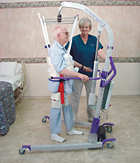
Making safe-lift programs a priority at long-term care facilities could be the key to reducing injuries and worker compensation costs, according to a new report.
The University of Maryland and the National Council on Compensation Insurance collaborated on a study to test the impact of safe lifting programs on worker’s compensation costs. Long-term care workers have the highest injury rates within the healthcare industry. The Bureau of Labor Statistics reports that in 2009, long-term care facilities had an injury rate of 8.4 per 100 full-time equivalent workers.
Researchers talked to directors of nursing in 200 different facilities that had been using mechanical lifting devices for a minimum of three years.
They found long-term care facilities with specific procedures and policies in place performed the best. For example, some facilities allowed the use of lifts only for immobile residents. Other facilities told CNAs that proper use of the lifts would be a component of their job performance evaluations.
The results showed that at the end of the survey period, close to 95% of facilities had powered mechanical lifts and 80% used them regularly. The investigators concluded that an emphasis on safe lift programs did appear to lower worker’s compensation costs and decrease the incidence of workplace injuries.
The growth in long-term care facilities is a direct result of an aging population. Caring for residents in long-term
facilities involves manual lifting, transferring from bed to chair, and repositioning residents. A nursing assistant was estimated to perform more than 20 lifts or transfers during an average eight-hour day shift, as reported in a related study.
From the May 01, 2011 Issue of McKnight's Long-Term Care News




